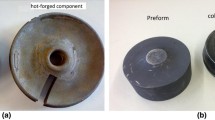Abstract
The role of cold work reduction and its effect on fatigue properties are examined by means of rotary beam fatigue testing. In this study, processing parameters from the initial ingot to the final size before finish drawing were held constant. Fatigue specimens were prepared with between 20 and 55% cold work in five percent increments. These samples were subsequently heat treated, cut into test sections at room temperature, and subjected to strain-controlled fatigue testing in a temperature-controlled RO water bath at a constant 10 °C above the measured active austenitic finish temperature (Af). An empirical analysis of the relationship between final reduction prior to heat treatment and fatigue lifetime is presented. Under alternating strain amplitudes greater than 1%, the 20 to 30% cold work level was found to deliver the greatest mean cycles to failure. Supplemental to the fatigue data, mechanocyclic and thermomechanical data are also presented as they evolve with prior retained cold work.










Similar content being viewed by others
References
K. Gall, J. Tyber, V. Brice, C. P. Frick, H. J. Maier, and N. Morgan, Tensile deformations of NiTi wires, J Biomed Mater Res, 75A, 2005, 810-823.
S. W. Robertson, X. Y. Gong, and R. O. Ritchie, Effect of product form and heat treatment on the crystallographic texture of austenitic nitinol, J Mater Sci, 41, 2006, 621-630.
M. H. Wu, Effects of phase transformations on fatigue endurance of a superelastic NiTi alloy, J ASTM Int, 4(3), 2007, 1–6.
E. McLucas, Y. Rochev, and W.M. Carroll, Analysis of the effects of surface treatments on nickel release from nitinol wires and their impact on candidate gene expression in endothelial cells, J Mater Sci: Mater Med, 19, 2008, 975–980.
M. Assad, L. H. Yahia, C. H. Rivard, and N. Lemieux, In vitro biocompatibility assessment of a nickel-titanium alloy using electron microscopy in situ end-labeling (EM-ISEL), J Biomed Mater Res, 41A, 1998, 154–161.
J. C. Wataha, P. E. Lockwood, M. Marek, and M. Ghazi, Ability of Ni-containing biomedical alloys to activate monocytes and endothelial cells in vitro, J Biomed Mater Res, 45A, 1999, 251–257.
M. M. Patel, Characterizing fatigue response of nickel-titanium alloys by rotary beam testing, J ASTM Int, 4, 2007, 1–11.
M. Reinoehl, D. Bradley, R. Bouthot, and J. Proft, The Influence of Melt Practice on Final Fatigue Properties of Superelastic NiTi Wires, SMST-2000: Proceedings of the International Conference on Shape Memory and Superelastic Technologies, S.M. Russell and A.R. Pelton, Eds., International Organization on SMST, 2001, p 397–403
D. Tolomeo, S. Davidson, and M. Santinoranont, Cyclic Properties of Superelastic Nitinol: Design Implications, SMST-2000: Proceedings of the International Conference on Shape Memory and Superelastic Technologies, S.M. Russell and A.R. Pelton, Eds., International Organization on SMST, 2001, p 471–476
T. Sawaguchi, G. Kaustrater, A. Yawny, M. Wagner, and G. Eggeler, Crack initiation and propagation in 50.9 at pct Ni-Ti pseudoelastic shape-memory wires in bending-rotation fatigue, Metall Mater Trans A, 34A, 2003, 2847–2860.
“Standard Test Method for Determination of Transformation Temperature of Nickel-Titanium Shape Memory Alloys by Bend and Free Recovery,” F2082-06, ASTM International, p 1–7
“Standard Terminology for Nickel-Titanium Shape Memory Alloys,” F2005-05, ASTM International, p 1–3
L. Tan and W. C. Crone, In situ TEM observation of two-step martensitic transformation in aged NiTi shape memory alloy, Scripta Metall Mater, 50, 2004, 819–823.
T. W. Duerig, Some unsolved aspects of nitinol, Mat Sci Eng A-Struct, 438, 2006, 69–74.
P. H. Adler, W. Yu, A. R. Pelton, R. Zadno, T. W. Duerig, and R. Baressi, On the tensile and torsional properties of pseudoelastic NiTi, Scripta Metall Mater, 24, 1990, 943–947.
W. M. Huang and H. K. Lim, Evolution of energy dissipation and the Young’s modulus in a martensite NiTi shape memory alloy wire upon cyclic loading, J Mater Sci Lett, 22, 2003, 1399–1400.
J.E. Schaffer, A Probabilistic Approach to Modeling Microstructural Variability and Fatigue Behavior in ASTM F562 Medical Grade Wire, in Proceedings of the 9th International Congress on Fatigue, Fatigue 2006, Atlanta, Georgia, USA, Elsevier Inc., Saint Louis, MO, USA, 2006.
T.W. Duerig and K.N. Melton, Diffuse Yield Drop and Snap Action in a NiTi Alloy, Materials Research Society Proceedings, Materials Research Society, Vol. 245, 1992, p 159–167
A. L. McKelvey and R. O. Ritchie, Fatigue crack growth behavior in the superelastic and shape memory alloy nitinol, Metall Mater Trans A, 32A, 2001, 731–743.
Author information
Authors and Affiliations
Corresponding author
Additional information
This article is an invited paper selected from presentations at Shape Memory and Superelastic Technologies 2008, held September 21-25, 2008, in Stressa, Italy, and has been expanded from the original presentation.
Rights and permissions
About this article
Cite this article
Schaffer, J.E., Plumley, D.L. Fatigue Performance of Nitinol Round Wire with Varying Cold Work Reductions. J. of Materi Eng and Perform 18, 563–568 (2009). https://doi.org/10.1007/s11665-009-9363-4
Received:
Revised:
Accepted:
Published:
Issue Date:
DOI: https://doi.org/10.1007/s11665-009-9363-4



